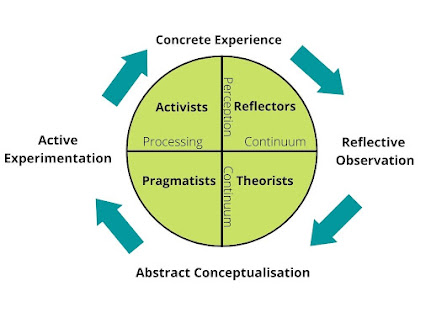The organizational learning process has three intricate stages; they are Knowledge acquisition, knowledge distribution, and shared implementation. Therefore organizational learning process has a close connection to knowledge management. Knowledge may come through first-hand experience, the experiences of others, or organizational memory (Armstrong, and Taylor, 2014).
Organizational
learning happens under two circumstances: first, when an organization achieves
its goals; and second when a discrepancy between goals and results is
discovered and fixed. These two learning processes are identified in this
theory as single-loop learning and double-loop learning. Adaptive or generative
learning are two terms used to characterize these two learning processes (Argyris,
1992 cited in Armstrong, and Taylor, 2014 ).
Single-loop learning
Single-loop
learning takes place when errors or problems are found, fixed, and
organizations continue to follow their rules and objectives. Correcting
mistakes and solving difficulties add to the firm's knowledge base,
firm-specific competencies, or processes without changing the core purpose of
the organization's operations (Kantamara, and Ractham, 2014). In organizations
where single-loop learning is the norm, the "governing variables" are
what the organization expects to accomplish in terms of goals and standards.
Then, the organization monitors and reviews progress and, if necessary, makes
corrections to close the loop. Single-loop or adaptive learning is gradual
learning that only corrects outliers (Armstrong, and Taylor, 2014). When dealing with ordinary and
recurrent problems that don't call for testing one's mental models,
presumptions, or learning framework, single-loop learning is appropriate.
Single loop learning has a constrained use, yet it is nevertheless essential
for standard operating procedures (Eilertsen, and London, 2005).
Double-loop learning
Double-loop
learning happens when an organization questions and modifies its underlying
norms, procedures, policies, and objectives in addition to identifying and
fixing mistakes. Changes to the knowledge base, company-specific competencies,
or practices are part of the process (Kantamara, and Ractham, 2014). Double-loop
or generative learning entails questioning rather than accepting presumptions,
beliefs, conventions, and conclusions. Based on this, learning through the
investigation of problem-underlying solving causes, to create a new learning
loop, that goes far deeper than the conventional learning loop offered by
single-loop or instrumental learning. Action is taken as a result of this
learning. The organizations can select how to proceed after learning something
new about what needs to be accomplished in light of the altered situation (Armstrong, and
Taylor, 2014).When
tackling complicated, non-programmable problems, double-loop learning is useful
since it is reflective. Members can start to gain the abilities needed to have
an impact on the system by realizing that they are a part of an interactional
system (Eilertsen, and London, 2005).
Figure 01: Single-loop and double-loop learning
Source: (Armstrong, and Taylor, 2014)
Figure 01 illustrates the Single-loop and double-loop learning
process.
Video 01: Organizational Learning - Single and
Double-Loop Learning
In this video, Brittany Tomasini describes the single and double-loop learning process using the process of a thermostat as an illustration.
Armstrong, M. & Taylor, S. (2014) Armstrong’s handbook of human resource management practice (13th ed). Kugan page limited.(Online).Available at https://www.academia.edu/32280546/ARMSTRONGS_HANDBOOK_OF_HUMAN_RESOURCE_MANAGEMENT_PRACTICE_i. Accessed on 28th July 2022.
Eilertsen, S. and London, K. (2005) Modes of Organizational Learning. The Kollner Group, Inc.(Online). Available at: http://drmichaelroe.weebly.com/uploads/2/8/1/8/2818319/single_and_double_loop_learning.pdf. Accessed on August 28, 2022.
Kantamara, P. and Ractham, V. V. (2014) Single-loop vs. Double-loop learning: An obstacle or a succes Factor for organizational learning. International Journal of Education and Research, 2(7), pp 55-62.(Online). Available at: https://www.ijern.com/journal/July-2014/05.pdf. Accessed on August 27, 2022.
Tomasini, B.
(2016) Organizational Learning - Single and Double-Loop Learning. (Video).
Available at: https://www.youtube.com/watch?v=boUoxw6sphs. Accessed on August 27, 2022.









